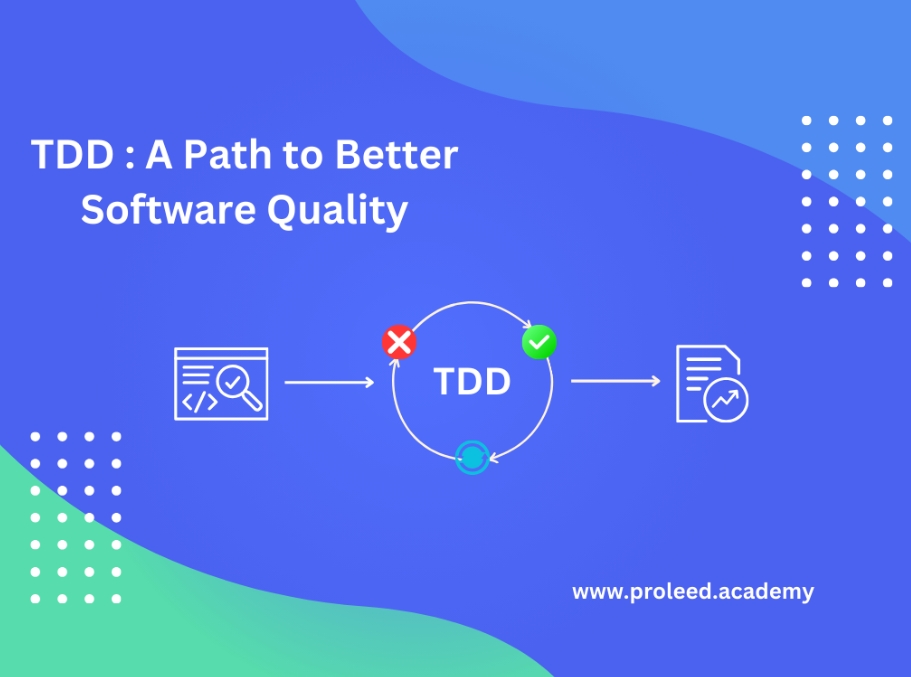Introduction
What is Test-Driven Development (TDD)?
How TDD Promotes Developer-Tester Cooperation
Tools and Frameworks to Aid TDD
Common Challenges and the Way Forward
TDD Best Practices for Testers and Developers
Why Developers and Testers Need TDD Skills
- Programming Better, Cleaner Code from the Beginning
- Bug Detection at the Early Stage and Debugging is Easier
- Better Teamwork Between Developers and Testers
- Capacity to Write More Effective and Relevant Tests
- Improving the Development Process and Codebase Understanding
- Providing Greater Test Automation Quality
- Real-World Examples of Developers and Testers Gaining from TDD
Conclusion
Introduction
In today’s hectic software development environment, the need for efficient, reliable and maintainable code takes center stage. Test Driven Development (TDD) is one of the finest methods to achieve quality software without compromising on a clean and efficient development process. TDD is not only a developers’ methodology it’s an essential skill which must be embraced by developers as well as testers to enhance the overall quality of software and also to promote better inter-team collaboration.
For testers who are just starting out with TDD or wish to upskill their testing skills, Software Testing Training can prove to be an excellent resource in learning the essentials and best practices behind TDD and other testing disciplines.
In this blog, we shall cover what is TDD, how it improves collaboration, the tools and frameworks that support TDD, common challenges faced and the best practices for both developers and testers. Lastly, we will discuss why developers and testers both require TDD skills and how it helps them write better code, catch bugs early, and ultimately deliver higher quality software.
What is Test Driven Development (TDD)?
Test-Driven Development (TDD) is a software development process in which developers first write a test and then code for a feature. The process follows a simple cycle:
- Red: Write a test for a feature which does not exist yet. The test should fail initially because the feature is yet to be implemented.
- Green: Write the minimum amount of code necessary to pass the test.
- Refactor: Make the code better while keeping the test passing.
This is done for every minor feature. The main idea behind TDD is that by writing tests first, developers ensure that every part of the application works from the start. This leads to cleaner, more maintainable code and reduces bugs from the software. In fact, adopting TDD is one of the best ways to improve the quality of the software, as discussed in TDD for better software, which further explains how this approach can lead to more reliable & well-structured code.
How TDD Promotes Developer-Tester Cooperation
Perhaps one of the best features of TDD is how it can bring developers and testers together more closely. Historically, development and test teams operate in separate silos—developers create the software, and then testers are brought on board to identify and repair bugs. TDD, on the other hand, engages both parties from the outset.
In TDD, the test is run actually first, thus enabling the testers to provide their feedback before the coding of the same is completed. This provides a feedback loop where both the developers and testers are working together towards a quality product.
1. Silo-breaking: TDD silo-breaks the conventional barriers between testers and developers. Rather than a process of sequential writing by developers followed by testing by them, TDD incorporates testing at every development step. Both participate in designing and verifying each feature.
2. Mutual ownership for quality: TDD allows mutual ownership of quality since developers and testers work together. Tests are written by developers as part of coding, and then the tests are verified and enhanced by the testers. Mutual ownership results in high-quality software that satisfies multiple requirements both functional and non-functional.
3. Ongoing feedback: TDD promotes ongoing feedback in the form of automated tests, hence problems do not become huge issues. The cycle of feedback enables teams to identify defects early during the development process, minimizing time and effort involved in fixing bugs in subsequent stages of the development process.
Tools and Frameworks to Aid TDD

TDD is a methodology, and like all methodologies, it needs the proper set of tools to work. The good news is that there are many testing frameworks and tools out there for different programming languages that assist in the TDD process.
Some popular tools for TDD are:
1. JUnit (Java): JUnit is a popular Java testing framework. It facilitates TDD via enabling the developers to write unit tests that can be automatically executed at any stage during the development process.
2. RSpec (Ruby): RSpec is Ruby behavior-driven development (BDD) testing software that facilitates TDD via the capability of the developers to write tests in human-readable code.
3. NUnit (for.NET): NUnit is a unit testing framework for.NET. It supports all the functionality to write, execute, and automate unit tests in order to test the code functionality.
4. Mocha (for JavaScript): Mocha is a dynamic JavaScript testing framework that can support both TDD and BDD. It is used widely along with Node.js applications for front-end and back-end testing.
5. PyTest (for Python): PyTest is a Python testing library that makes testing easy and supports TDD. It is easily compatible with other testing tools, and thus it is very popular among Python developers.
Jenkins and Travis CI also automate test running and continuous integration so that teams can have a hassle-free TDD process.
Common Challenges and the Way Forward
Although TDD has proven to be an effective practice, it is not without challenges. Testers as well as developers might encounter some challenges when employing TDD for the first time. Some of the common challenges and their resolutions are given below:
1. Learning curve at first: It is a big adjustment for developers to get used to learning test writing prior to code writing. The answer is practice and adding TDD to the development process gradually. Begin with basic tests and incrementally build upon them will make the learning curve less steep.
2. Time investment: Others opine that tests written ahead of time are more time-consuming to write. TDD, however, reduces debugging and maintenance time in the long term. In the long term, development gets quicker as developers become accustomed to the process.
3. Legacy systems and TDD: Legacy systems with weak test coverage will complicate the introduction of TDD. A staged rollout—new features first, then refactored legacy code in small steps—will make it easier to introduce TDD without affecting the current codebase.
4. Change resistance: Teams will resist implementing TDD due to a change of attitude. Incremental training and small projects will provide confidence and show the benefits.
TDD Best Practices for Testers and Developers
Testers and developers must follow some best practices for TDD to be successful:
- Write small but meaningful tests: Focus should be on testing one very small piece of functionality at a time. Since small tests are simpler to write, less hard to debug and quicker to run.
- Keep tests decoupled: Ensure each test is independent of others. This makes the tests readable and maintainable.
- Automate testing: The success of TDD depends completely on automation. Execute automated tests frequently to provide instant feedback and catch issues early.
- Refactor regularly: Refactoring is included in the TDD cycle. Try to improve the code continuously while ensuring the tests pass.
- Readability focus: Tests should be written in a way that it was easy for both the developers and the testers to understand. Since this greatly facilitates coordination and also makes tests maintainable.
Why TDD Skills are Needed by Developers and Testers

- Programming Better, Cleaner Code from the Beginning
TDD makes developers think more critically about the code that they will write before they even start. With the tests written first, developers know that their code is meaningful and that it complies with the requirement from the beginning. This leads to cleaner, more efficient code that is also easier to maintain.
- Bug Detection at the Early Stage and Debugging is Easier
Since tests are written before code, bugs are detected early in the development process. The process of writing a failing test, writing code to make the test pass, and refactoring it helps catch errors and correct them before they become larger, more expensive problems.
- Better Teamwork Between Developers and Testers
As is being argued above, TDD promotes harmony among testers and developers. Both are engaged right from the start, which results in improved communication and fewer misunderstandings. This results in more precise testing and better overall software quality.
- Capacity to Write More Effective and Relevant Tests
TDD guarantees that the tests are properly synchronized with the code functionality. Testers and developers are able to write the tests to mirror the real requirements without duplicative or immaterial test cases.
- Improving the Development Process and Codebase Understanding
TDD enables both developers and test engineers to understand the code and requirements more clearly. Test-driven development compels developers to deconstruct complicated issues into pieces that are easy to handle, facilitating both roles to better understand the system.
- Providing Greater Test Automation Quality
Automated tests drive the TDD process. Developers and testers who are proficient in TDD are able to write high-quality, dependable automated tests that enhance the overall test process and guarantee that software is always properly tested.
- Real-World Examples of Developers and Testers Gaining from TDD
Most technology businesses, including Google, Microsoft, and Spotify, have embraced the practice of TDD to deliver better-quality software. Developers who work in a TDD context indicate fewer bugs, quicker production time, and easier-to-maintain code. Testers and developers practicing TDD find themselves more connected to the coding process and better assured of their output’s quality.
Conclusion
Test Driven Development or TDD is a method that should be known by every tester and developer. It makes teams collaborate more effectively which results in more clean code and eliminating bugs early. No doubt there are many challenges involved in adopting TDD but their long term benefits of higher quality code, quicker development and increased communication among teams outweigh the learning process by a wide margin. With today’s software dominated environment, TDD is a useful skill that each tester and developer must acquire to write high quality software effectively and efficiently.



































